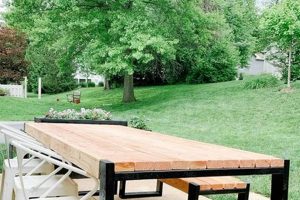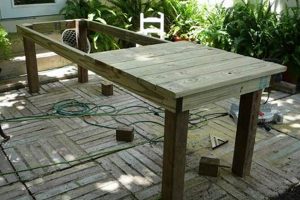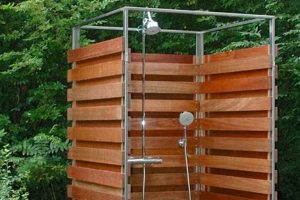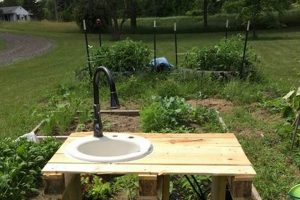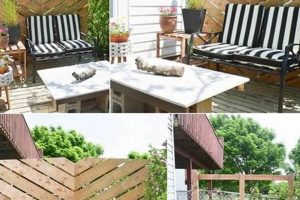A do-it-yourself open-air bathing area provides a space for personal hygiene and relaxation located outside the primary dwelling. These constructions often incorporate elements of nature, privacy screening, and weather protection. An example would be a shower enclosure built with reclaimed wood and surrounded by bamboo for seclusion.
The construction of ablution facilities beyond the confines of the home can offer several advantages, including enhanced connection with nature, supplementary bathing capacity, and a solution for rinsing off after outdoor activities. Historically, exterior washing areas have been prevalent in cultures where indoor plumbing was limited or where bathing rituals were closely tied to natural elements.
Subsequent sections will elaborate on design considerations, material selection, construction techniques, and regulatory compliance related to the creation of these customized exterior bathing facilities.
Essential Considerations for Exterior Bathing Area Projects
The successful implementation of a customized open-air bathing space necessitates careful planning and execution. Attention to detail in design, material selection, and construction methods is paramount.
Tip 1: Site Selection: Thoroughly assess the designated location. Consider factors such as sun exposure, prevailing winds, drainage, proximity to existing plumbing lines, and privacy from neighboring properties. Improper site selection can lead to discomfort and necessitate costly modifications.
Tip 2: Plumbing Integration: Engage a qualified plumber to ensure proper connection to the existing water supply and drainage systems. Compliance with local plumbing codes is essential to prevent leaks, water damage, and potential health hazards. Alternatives like rainwater harvesting systems should meet potable water standards, if applicable.
Tip 3: Material Durability: Choose materials resistant to weathering, moisture, and insect infestation. Options include treated lumber, composite decking, stone, and concrete. Untreated materials will deteriorate rapidly, requiring frequent repairs or replacement.
Tip 4: Privacy Screening: Incorporate features like fencing, latticework, strategically planted vegetation, or solid walls to create a private and secluded bathing environment. The level of privacy should be tailored to the specific location and user preferences. Opaque screens are preferable in densely populated areas.
Tip 5: Drainage Management: Implement a robust drainage system to prevent water accumulation and potential damage to surrounding structures or landscaping. Consider the use of permeable paving materials or French drains to effectively manage runoff. Poor drainage can lead to erosion and mosquito breeding.
Tip 6: Weather Protection: Consider the addition of a roof or partial enclosure to provide protection from rain, sun, and wind. Overhangs, pergolas, or retractable awnings can enhance comfort and extend the usability of the space throughout the year. Adequate weather protection minimizes exposure to the elements.
Tip 7: Lighting Considerations: Install appropriate lighting fixtures to ensure safe and comfortable use during nighttime hours. Options include low-voltage landscape lighting, solar-powered lamps, or strategically placed spotlights. Proper illumination enhances safety and creates a pleasant ambiance.
Careful adherence to these recommendations can help ensure the creation of a functional, durable, and aesthetically pleasing exterior bathing facility. Prioritizing safety, practicality, and compliance with regulations will yield a long-lasting and enjoyable outdoor amenity.
The final section will summarize the entire process and offer closing thoughts.
1. Design
Design constitutes the foundational blueprint for any exterior bathing area. It directly influences functionality, aesthetics, cost, and longevity. Neglecting a comprehensive design phase can result in a structure that is impractical, visually unappealing, prone to disrepair, or in violation of local building codes. For example, a design that fails to account for prevailing wind direction may render the shower unusable on windy days, thereby negating its intended purpose. Conversely, a well-considered design will optimize space utilization, incorporate privacy elements, and ensure efficient drainage, resulting in a durable and comfortable open-air bathing experience.
Practical application of sound design principles extends to material selection. The design dictates the quantities and types of materials required, directly impacting the project’s budget. For example, a minimalist design employing readily available lumber can significantly reduce material costs compared to an elaborate design incorporating custom-fabricated elements or exotic hardwoods. Furthermore, the design must integrate plumbing and electrical considerations seamlessly, ensuring that water supply lines, drainage pipes, and lighting fixtures are properly located and installed. Consider, for instance, a plan that cleverly hides plumbing within structural supports, minimizing visual intrusion and maintaining the aesthetic integrity of the space.
Ultimately, the design phase serves as a critical risk mitigation strategy. Addressing potential challenges related to site conditions, privacy concerns, material durability, and regulatory compliance during the initial planning stages can prevent costly alterations or even complete project failure. A meticulously crafted design, therefore, represents an indispensable component of a successful exterior bathing area.
2. Materials
Material selection represents a critical determinant of the longevity, aesthetic appeal, and overall functionality of any exterior bathing area project. The properties of chosen materials directly impact resistance to weather, ease of maintenance, and adherence to local building codes. Consequently, careful consideration of material characteristics is essential for achieving a successful outcome.
- Weather Resistance
Materials exposed to the elements must exhibit substantial resistance to moisture, sunlight, and temperature fluctuations. Untreated wood, for example, is prone to rot and insect infestation, rendering it unsuitable for prolonged outdoor use. Conversely, treated lumber, composite decking, and certain types of stone offer superior weather resistance and are commonly employed in exterior construction. The selection of weather-resistant materials is paramount to preventing premature degradation and ensuring structural integrity.
- Maintenance Requirements
The level of maintenance required for different materials varies considerably. Natural wood, while aesthetically pleasing, typically necessitates regular sealing or staining to prevent moisture damage. Composite materials, on the other hand, generally require minimal maintenance, often only requiring occasional cleaning with soap and water. Opting for low-maintenance materials can significantly reduce long-term costs and effort associated with upkeep.
- Aesthetic Considerations
Material choice plays a significant role in the overall aesthetic appeal of the space. The use of natural stone, for example, can evoke a sense of rustic elegance, while the incorporation of sleek metal accents can contribute to a more modern design. The selected materials should complement the surrounding landscape and reflect the desired aesthetic sensibilities. Thoughtful consideration of color, texture, and pattern can enhance the visual appeal of the exterior bathing area.
- Cost Implications
Material costs can vary widely depending on availability, quality, and type. Exotic hardwoods and custom-fabricated elements tend to be significantly more expensive than readily available lumber and standard components. Balancing aesthetic preferences with budgetary constraints is often necessary. Exploring cost-effective alternatives without compromising durability or functionality is a prudent approach to material selection.
In summary, the selection of appropriate materials necessitates a holistic approach that considers weather resistance, maintenance requirements, aesthetic preferences, and budgetary limitations. Prioritizing durability and functionality while adhering to aesthetic goals will contribute to a long-lasting and visually appealing addition to the outdoor environment.
3. Plumbing
The integration of plumbing systems is a non-negotiable aspect of a functional open-air bathing area. Proper plumbing ensures the delivery of potable water and the safe removal of wastewater, adhering to local regulations and safeguarding public health. Inadequate plumbing can lead to unsanitary conditions, property damage, and legal repercussions.
- Water Supply Lines
Water supply lines are responsible for delivering water to the showerhead, faucet, or other water fixtures within the outdoor bathroom. These lines typically connect to the existing residential plumbing system. Material selection for these lines is critical; options such as copper, PEX, or CPVC offer varying degrees of durability and resistance to freezing. In colder climates, insulation or heat tracing of water supply lines is often necessary to prevent freezing and potential pipe bursts. Improperly installed supply lines can result in leaks, reduced water pressure, or contaminated water.
- Drainage Systems
Drainage systems are essential for the efficient removal of wastewater from the bathing area. These systems typically consist of a drain, a trap, and a drain line that connects to the main sewer line or a septic system. The drain must be adequately sized to handle the anticipated water flow, preventing standing water and potential slip hazards. Traps prevent sewer gases from entering the bathing area, mitigating unpleasant odors and potential health risks. Drain lines must be properly sloped to ensure gravity-driven flow and prevent clogs. Failure to properly design and install a drainage system can lead to water damage, mold growth, and unsanitary conditions.
- Hot Water Heaters
The provision of hot water necessitates the installation of a hot water heater. Options include tankless water heaters, which provide on-demand hot water, and traditional tank-style heaters. Tankless heaters offer space-saving advantages and eliminate standby heat loss, while tank-style heaters may be more cost-effective for high-volume hot water usage. The capacity of the hot water heater should be sufficient to meet the demands of the bathing area. Improperly sized or installed hot water heaters can result in insufficient hot water or energy inefficiencies.
- Backflow Prevention
Backflow prevention devices are crucial for protecting the potable water supply from contamination. These devices prevent wastewater from flowing backward into the water supply lines, which can occur due to pressure fluctuations or other plumbing issues. Backflow preventers are often required by local plumbing codes and should be installed by a qualified plumber. Neglecting backflow prevention can lead to serious health risks and legal liabilities.
The proper integration of these plumbing components is paramount for a safe, functional, and code-compliant open-air bathing area. Engaging a licensed plumber is strongly recommended to ensure that all plumbing work is performed correctly and in accordance with local regulations, minimizing the risk of costly repairs or hazardous conditions.
4. Privacy
The implementation of a customized open-air bathing area inherently presents unique privacy challenges that necessitate careful consideration during the design and construction phases. The absence of traditional walls and a roof demands strategic planning to ensure user comfort and compliance with local ordinances. A failure to address privacy concerns can render the facility unusable or create legal conflicts with neighboring properties.
Several design solutions can effectively mitigate privacy issues. Solid walls, constructed from materials such as wood, stone, or concrete, provide a physical barrier against unwanted views. Strategic landscaping, incorporating dense plantings of trees, shrubs, or bamboo, can create a natural screen. Fencing, latticework, or decorative panels offer semi-private options, allowing for airflow while obscuring direct visibility. The selection of appropriate screening methods depends on site conditions, local regulations, and the desired level of seclusion. For example, in densely populated urban areas, solid walls or high fences may be necessary to achieve adequate privacy, while in rural settings, natural landscaping may suffice. Furthermore, the orientation of the bathing area should be carefully considered to minimize visibility from neighboring windows or public spaces. A real-world example involves a homeowner who erected a bathing facility without adequate screening, resulting in complaints from neighbors and a subsequent legal order to modify the structure to comply with privacy regulations.
In conclusion, privacy is a paramount concern in the design and construction of exterior bathing areas. Addressing this concern requires a comprehensive assessment of site conditions, local regulations, and user preferences. Implementing appropriate screening methods, such as solid walls, strategic landscaping, or decorative panels, is essential to creating a comfortable and legally compliant open-air bathing environment. The careful planning and execution of privacy measures represent a critical component of a successful project.
5. Drainage
Effective drainage constitutes a critical, often overlooked, component of any do-it-yourself open-air bathing area. The presence of standing water post-use creates a breeding ground for mosquitos, promotes mold growth, and accelerates the deterioration of structural materials. The absence of a properly engineered drainage system directly undermines the intended hygienic and recreational function of the bathing area, potentially leading to health hazards and property damage. As an example, consider a shower constructed on a slightly sloped concrete pad without adequate run-off channels; rainwater and shower discharge will pool, fostering algae and creating a slip hazard.
Various drainage solutions exist, ranging from simple to complex. A gravel base provides a permeable surface that allows water to percolate into the ground, suitable for areas with well-draining soil. French drains, consisting of perforated pipes buried in gravel-filled trenches, efficiently channel water away from the structure. More elaborate systems may involve connecting the shower drain to the existing residential sewer system, requiring adherence to local plumbing codes and potentially necessitating professional installation. A poorly executed connection to a septic system, for instance, can lead to system overload and environmental contamination.
In summary, proper drainage is not merely an aesthetic consideration, but an essential functional element of a exterior bathing facility. The investment in a well-designed and properly installed drainage system is crucial for maintaining hygiene, preventing property damage, and ensuring the long-term viability of the structure. Neglecting drainage can negate the benefits and add significant costs over the lifespan of the design.
6. Regulations
Compliance with local, regional, and national regulations is paramount in the construction of a do-it-yourself open-air bathing area. Regulatory adherence ensures safety, protects property values, and avoids potential legal ramifications. Neglecting these guidelines can result in costly modifications, fines, or even the complete dismantling of the structure.
- Building Codes
Local building codes govern the structural integrity and safety of any construction project. These codes specify requirements for foundations, framing, and material usage to ensure the structure can withstand environmental stresses like wind and snow. In the context of an outdoor bathroom, these codes dictate the permissible height of walls, the required setback distances from property lines, and the acceptable types of materials for weather-exposed elements. Failure to comply with building codes can lead to safety hazards and invalidate property insurance coverage.
- Plumbing Codes
Plumbing codes regulate the installation of water supply and drainage systems. These codes dictate pipe sizes, materials, and connection methods to prevent leaks, contamination, and unsanitary conditions. Outdoor bathrooms require proper connection to the existing water supply and sewage disposal systems. Plumbing codes mandate the use of backflow preventers to protect the potable water supply and specify drainage requirements to prevent standing water. Violations of plumbing codes can result in water damage, health risks, and fines from regulatory agencies.
- Electrical Codes
Electrical codes govern the safe installation of electrical wiring and fixtures. These codes specify wiring types, grounding requirements, and protection measures to prevent electrical shocks and fires. Outdoor bathrooms with electrical lighting or outlets must comply with electrical codes, ensuring that wiring is weatherproofed and properly grounded. The installation of ground fault circuit interrupters (GFCIs) is often required to protect against electrical hazards in wet environments. Non-compliance with electrical codes can pose serious safety risks and lead to electrical fires.
- Zoning Regulations
Zoning regulations dictate the permissible uses of land and the types of structures that can be built on a given property. These regulations specify setback distances from property lines, height restrictions, and permitted uses of outdoor spaces. Outdoor bathrooms must comply with zoning regulations, ensuring that the structure is located in an area where it is permitted and that it does not violate setback or height restrictions. Zoning violations can result in fines, legal action, and orders to remove the structure.
The multifaceted nature of regulations necessitates thorough research and diligent adherence. Consulting with local building officials, licensed plumbers, and electricians is advisable to ensure compliance with all applicable codes and regulations. A proactive approach to regulatory compliance minimizes the risk of costly mistakes and ensures the safe and legal construction of the exterior bathing area.
Frequently Asked Questions
The following questions address common concerns and misconceptions regarding the design, construction, and regulation of outdoor bathing facilities.
Question 1: Is a permit required for the construction of an open-air shower?
The necessity for a permit varies based on jurisdictional regulations. Most municipalities require permits for structures altering existing plumbing or electrical systems, or those exceeding specific size thresholds. Contacting the local building department is advisable to ascertain permit requirements before commencing any construction.
Question 2: What are the optimal materials for weather resistance in an outdoor bathroom?
Materials exhibiting superior weather resistance include treated lumber, composite decking, stone, and certain types of metal. Untreated wood is prone to rot and insect infestation. Careful material selection minimizes maintenance and extends the lifespan of the structure.
Question 3: How can privacy be effectively achieved in an outdoor bathing space?
Privacy can be enhanced through the incorporation of solid walls, strategically placed landscaping, fencing, or latticework. The selection of appropriate screening methods depends on site conditions, local regulations, and desired level of seclusion.
Question 4: What drainage solutions are suitable for open-air showers?
Drainage solutions encompass gravel bases, French drains, and connections to the existing sewer system. The choice depends on soil conditions, water volume, and local plumbing codes. Adequate drainage prevents standing water, mold growth, and slip hazards.
Question 5: What measures are necessary to prevent freezing pipes in colder climates?
In colder climates, insulating water supply lines is essential to prevent freezing and potential pipe bursts. Heat tracing cables offer an additional layer of protection. Winterization procedures may involve draining water lines during extended periods of sub-freezing temperatures.
Question 6: How does one ensure compliance with local building codes?
Compliance with building codes necessitates thorough research of local regulations and consultation with building officials. Obtaining the necessary permits and adhering to all specified requirements are crucial steps in ensuring regulatory compliance and avoiding potential legal ramifications.
These FAQs highlight essential considerations for constructing a safe, functional, and legally compliant exterior bathing facility. A proactive approach to planning, material selection, and regulatory compliance minimizes risks and maximizes the enjoyment of the outdoor space.
The following section will provide a step-by-step guide.
diy outdoor bathroom
This exploration has underscored the multifaceted aspects of designing and constructing a do-it-yourself open-air bathing area. Key points include the importance of regulatory compliance, appropriate material selection, efficient plumbing integration, and the strategic implementation of privacy measures. A failure to adequately address any of these elements can compromise the functionality, longevity, and legality of the structure.
The creation of an exterior bathing facility demands meticulous planning and execution. While the allure of an open-air bathing experience is undeniable, prospective builders must prioritize safety and code adherence. The resulting structure, when properly conceived and constructed, represents a valuable addition to the outdoor environment, offering both utility and aesthetic enhancement.


